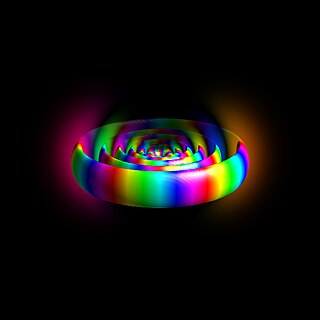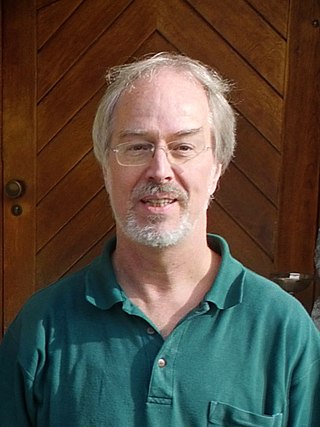Related Research Articles

In atomic physics and chemistry, an atomic electron transition is a change of an electron from one energy level to another within an atom or artificial atom. It appears discontinuous as the electron "jumps" from one quantized energy level to another, typically in a few nanoseconds or less.

In physics, polaritons are quasiparticles resulting from strong coupling of electromagnetic waves with an electric or magnetic dipole-carrying excitation. They are an expression of the common quantum phenomenon known as level repulsion, also known as the avoided crossing principle. Polaritons describe the crossing of the dispersion of light with any interacting resonance. To this extent polaritons can also be thought of as the new normal modes of a given material or structure arising from the strong coupling of the bare modes, which are the photon and the dipolar oscillation. The polariton is a bosonic quasiparticle, and should not be confused with the polaron, which is an electron plus an attached phonon cloud.

In physics, superlubricity is a regime of motion in which friction vanishes or very nearly vanishes. What is a "vanishing" friction level is not clear, which makes the term quite vague. As an ad hoc definition, a kinetic coefficient of friction less than 0.01 can be adopted. This definition also requires further discussion and clarification.
Naomi J. Halas is the Stanley C. Moore Professor in Electrical and Computer Engineering, and professor of biomedical engineering, chemistry and physics at Rice University. She is also the founding director of Rice University Laboratory for Nanophotonics, and the Smalley-Curl Institute. She invented the first nanoparticle with tunable plasmonic resonances, which are controlled by their shape and structure, and has won numerous awards for her pioneering work in the field of nanophotonics and plasmonics. She was also part of a team that developed the first dark pulse soliton in 1987 while working for IBM.

A Rydberg atom is an excited atom with one or more electrons that have a very high principal quantum number, n. The higher the value of n, the farther the electron is from the nucleus, on average. Rydberg atoms have a number of peculiar properties including an exaggerated response to electric and magnetic fields, long decay periods and electron wavefunctions that approximate, under some conditions, classical orbits of electrons about the nuclei. The core electrons shield the outer electron from the electric field of the nucleus such that, from a distance, the electric potential looks identical to that experienced by the electron in a hydrogen atom.
Phaedon Avouris is a Greek chemical physicist and materials scientist. He is an IBM Fellow and was formerly the group leader for Nanometer Scale Science and Technology at the Thomas J. Watson Research Center in Yorktown Heights, New York.

Sound amplification by stimulated emission of radiation (SASER) refers to a device that emits acoustic radiation. It focuses sound waves in a way that they can serve as accurate and high-speed carriers of information in many kinds of applications—similar to uses of laser light.
Hongkun Park is Mark Hyman Jr. Professor of Chemistry and Professor of Physics at Harvard University. He received his BS in chemistry at Seoul National University in 1990, and his PhD in physical chemistry at Stanford University in 1996 under Richard Zare. From 1996 to 1999 he was a postdoctoral fellow at Lawrence Berkeley National Laboratory under A. Paul Alivisatos and Paul McEuen.
A nanolaser is a laser that has nanoscale dimensions and it refers to a micro-/nano- device which can emit light with light or electric excitation of nanowires or other nanomaterials that serve as resonators. A standard feature of nanolasers includes their light confinement on a scale approaching or suppressing the diffraction limit of light. These tiny lasers can be modulated quickly and, combined with their small footprint, this makes them ideal candidates for on-chip optical computing.
Yambo is a computer software package for studying many-body theory aspects of solids and molecule systems. It calculates the excited state properties of physical systems from first principles, e.g., from quantum mechanics law without the use of empirical data. It is an open-source software released under the GNU General Public License (GPL). However the main development repository is private and only a subset of the features available in the private repository are cloned into the public repository and thus distributed.

In quantum computing, and more specifically in superconducting quantum computing, a transmon is a type of superconducting charge qubit that was designed to have reduced sensitivity to charge noise. The transmon was developed by Robert J. Schoelkopf, Michel Devoret, Steven M. Girvin, and their colleagues at Yale University in 2007. Its name is an abbreviation of the term transmission line shunted plasma oscillation qubit; one which consists of a Cooper-pair box "where the two superconductors are also capacitatively shunted in order to decrease the sensitivity to charge noise, while maintaining a sufficient anharmonicity for selective qubit control".
Photonic molecules are a form of matter in which photons bind together to form "molecules". They were first predicted in 2007. Photonic molecules are formed when individual (massless) photons "interact with each other so strongly that they act as though they have mass". In an alternative definition, photons confined to two or more coupled optical cavities also reproduce the physics of interacting atomic energy levels, and have been termed as photonic molecules.

Gerhard Rempe is a German physicist, Director at the Max Planck Institute of Quantum Optics and Honorary Professor at the Technical University of Munich. He has performed pioneering experiments in atomic and molecular physics, quantum optics and quantum information processing.

Plasmonics or nanoplasmonics refers to the generation, detection, and manipulation of signals at optical frequencies along metal-dielectric interfaces in the nanometer scale. Inspired by photonics, plasmonics follows the trend of miniaturizing optical devices, and finds applications in sensing, microscopy, optical communications, and bio-photonics.
Ania Bleszynski Jayich is an American experimental physicist most known for developing novel sensing techniques that shed light on important biological, condensed matter, and quantum mechanical systems. Bleszynski Jayich is the Bruker Endowed Chair in Science and Engineering in the Department of Physics at the University of California, Santa Barbara and Associate Director of the campus’s Materials Research Lab.

Prineha Narang is an American physicist and computational material scientist. She is a Professor of Physical Sciences and Howard Reiss Chair at the University of California, Los Angeles (UCLA). Narang currently serves as a U.S. Science Envoy approved by the Secretary of State to identify opportunities for science and technology cooperation. Before moving to UCLA, she was first an Environmental Fellow at Harvard University Center for the Environment and then an Assistant Professor in the John A. Paulson School of Engineering and Applied Sciences at Harvard University. Narang’s work has been recognized internationally by many awards and a variety of special designations, including the Mildred Dresselhaus Prize, the 2021 IUPAP Young Scientist Prize in Computational Physics, a Friedrich Wilhelm Bessel Research Award from the Alexander von Humboldt Foundation, and a Max Planck Sabbatical Award from the Max Planck Society. Narang also received a National Science Foundation CAREER Award in 2020, was named a Moore Inventor Fellow by the Gordon and Betty Moore Foundation for the development for a fundamentally new strategy for single molecule sensing and environmental toxin metrology using picoscale quantum sensors, CIFAR Azrieli Global Scholar by the Canadian Institute for Advanced Research, and a Top Innovator by MIT Tech Review. Narang was awarded a Guggenheim Fellowship in 2023.
Paola Cappellaro is an Italian-American engineer who is a Professor of Nuclear Science and Engineering at the Massachusetts Institute of Technology. Her research considers electron-spin resonance, nuclear magnetic resonance and quantum information processing. She leads the MIT Quantum Engineering Group at the Center for Ultracold Atoms.
Amalia Ioana Coldea is a Romanian quantum physicist who is an Associate Professor at the University of Oxford. She was awarded the 2019 Institute of Physics Brian Pippard Prize and the 2011 EuroMagnet Prize.

Marissa Giustina is an American physicist who is a senior research scientist at the Quantum Artificial Intelligence Lab. Her research considers the development of quantum computing and experimental tests of quantum theory.
Mary R. M. Bishai is an American physicist who is a Distinguished Scientist at Brookhaven National Laboratory. In 2023, she was elected spokesperson of Deep Underground Neutrino Experiment, and was made responsible for the 1,400 person collaboration. She was named a Fellow of the American Physical Society in 2015.
References
- 1 2 "Welcomes Nathalie de Leon (Princeton University) | QFARM". qfarm.stanford.edu. Stanford University. Retrieved September 1, 2022.
- 1 2 Lyon, Scott (October 7, 2022). "Solid-state expert Nathalie de Leon has won the APS quantum computing award". Electrical and Computer Engineering. Retrieved February 12, 2023.
- ↑ de Leon, Nathalie P.; Lukin, Mikhail D.; Park, Hongkun (2012). "Quantum Plasmonic Circuits". IEEE Journal of Selected Topics in Quantum Electronics. 18 (6): 1781–1791. CiteSeerX 10.1.1.453.8971 . doi:10.1109/JSTQE.2012.2197179. S2CID 16846746.[ non-primary source needed ]
- 1 2 3 American Institute of Physics (March 15, 2022). "Nathalie de Leon". www.aip.org. Retrieved September 6, 2022.
- ↑ de Leon, Nathalie Pulmones (2011). Engineering confined Electrons and Photons at the Nanoscale (Thesis). ProQuest 877967609.[ non-primary source needed ]
- ↑ de Leon, Nathalie P.; Shields, Brendan J.; Yu, Chun L.; Englund, Dirk E.; Akimov, Alexey V.; Lukin, Mikhail D.; Park, Hongkun (May 31, 2012). "Tailoring Light-Matter Interaction with a Nanoscale Plasmon Resonator". Physical Review Letters. 108 (22): 226803. arXiv: 1202.0829 . doi:10.1103/PhysRevLett.108.226803. PMID 23003638. S2CID 6880833.[ non-primary source needed ]
- ↑ "Nathalie De Leon receives U.S. Air Force Young Investigator award". Office of the Dean for Research. October 18, 2016. Retrieved February 12, 2023.
- ↑ "de Leon named as 2017 Sloan Research Fellow". Electrical and Computer Engineering. February 27, 2017. Retrieved February 12, 2023.
- ↑ "NSF Award Search: Award # 1752047 - CAREER: Novel Diamond Surface Functionalization and Nanoscale Surface Spectroscopy for Quantum Applications". www.nsf.gov. Retrieved February 12, 2023.
- ↑ "FY 2018 DOE Office of Science Early Career Research Program Award Abstracts (06-27-2018)" (PDF). July 6, 2018.